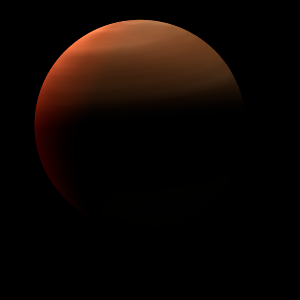|
|
Space Astro
|
Info for exoplanet "Suri-tepon"
| Scientific (actual) data |
|---|
| Name | KMT-2021-BLG-1643 b |
| Planet status | Confirmed |
| Planet mass | 61 |
| Semi major axis | 5.36 |
| Discovered | 2023 |
| Updated | 2023-07-12 |
| Publication | Published in a refereed paper |
| Detection type | Microlensing |
| Mass measurement type | Microlensing |
| Star name | KMT-2021-BLG-1643 |
| Right ascension | 270.64° |
| Declination | -30.61° |
| Wikipedia article | KMT-2021-BLG-1643 b |
Back
| |
| Fictional info (?) |
|---|
| Suggested name | Suri-tepon |
| Planet type | Huge cold gas giant |
| The two polar ice caps appear to be made largely of frozen gas. |
| Atmosphere | Water vapor | 47% |
| Sulfur dioxide | 40% |
| Ammonia | 7.6% |
| Ammonium hydrosulfide (NH4SH) | 2.8% |
| Nitric oxide | 2.1% |
| Formaldehyde | 0.24% |
| Atmospheric pressure | 1.9 bar |
 |
| No known satellites |
| Google search for Suri-tepon |
|
Website by Joachim Michaelis
|
|
|
|